Arusha is home to various birds, with over 250 species of birds recorded in the area. From the colorful Flamingos of Lake Manyara to the majestic Secretary Birds of the Serengeti, Arusha is a paradise for birdwatchers.
With various habitats, there is something for every type of birder. From the wetlands of the Arusha National Park to the forests of Mount Meru, Arusha is an excellent place to spot various birds.
Arusha is an ideal destination for bird watching with a range of water birds, raptors, songbirds, and more.
24 Birds to Watch in Arusha
Arusha is a city in northern Tanzania, located at the foot of Mount Meru, one of Africa’s highest mountains. It is also a gateway to some of the most famous national parks and wildlife reserves in the world, such as Serengeti, Ngorongoro, Tarangire, and Lake Manyara.
Here are 24 birds that you should not miss when visiting Arusha.
1. Common Ostrich
The common ostrich is a bird species native to certain parts of Africa. It is the only member of the genus Struthio in the ratite order of birds, a group of flightless birds.
These birds are large, with long legs and wings that are too small for them to be able to fly. The ostrich is the only bird in the world with two toes on each foot, which helps them to dash.
They also have long necks and small heads with large eyes, allowing them to see predators from far away. Ostriches are also capable of running very fast, reaching speeds of up to 40 miles per hour.
They mainly feed on plants, fruits, seeds, and insects and can survive in various habitats, from deserts to grasslands.
| Kingdom | Animalia |
| Phylum | Chordata |
| Class | Aves |
| Order | Struthioniformes |
| Family | Struthionidae |
| Genus | Struthio |
| Species | S. camelus |
2. Kori Bustard
The kori bustard is an impressive bird species native to Africa. It is a member of the bustard family, including other species only found in the Old World. It is the largest species among the four species within the genus Ardeotis and the only one found in Africa.
Its impressive size is due to its long legs and mighty wings, which allow it to fly long distances in search of food. The kori bustard is an omnivore, feeding on small animals, seeds, and insects.
It lives in open grasslands, savannas, and lightly wooded areas rarely seen in forests or dense vegetation. Its plumage is typically brown or grey, with distinctive black stripes and markings.
The kori bustard can be identified by its long neck, which is covered in white feathers, and its distinctive facial pattern. The kori bustard is an essential species in its ecosystem, acting as a predator of small animals and a disperser of seeds.
It is also an important game bird for hunters in Africa, and its population is currently listed as vulnerable due to the destruction of its habitat.
| Kingdom | Animalia |
| Phylum | Chordata |
| Class | Aves |
| Order | Otidiformes |
| Family | Otididae |
| Genus | Ardeotis |
| Species | A. kori |
3. Greater Flamingo
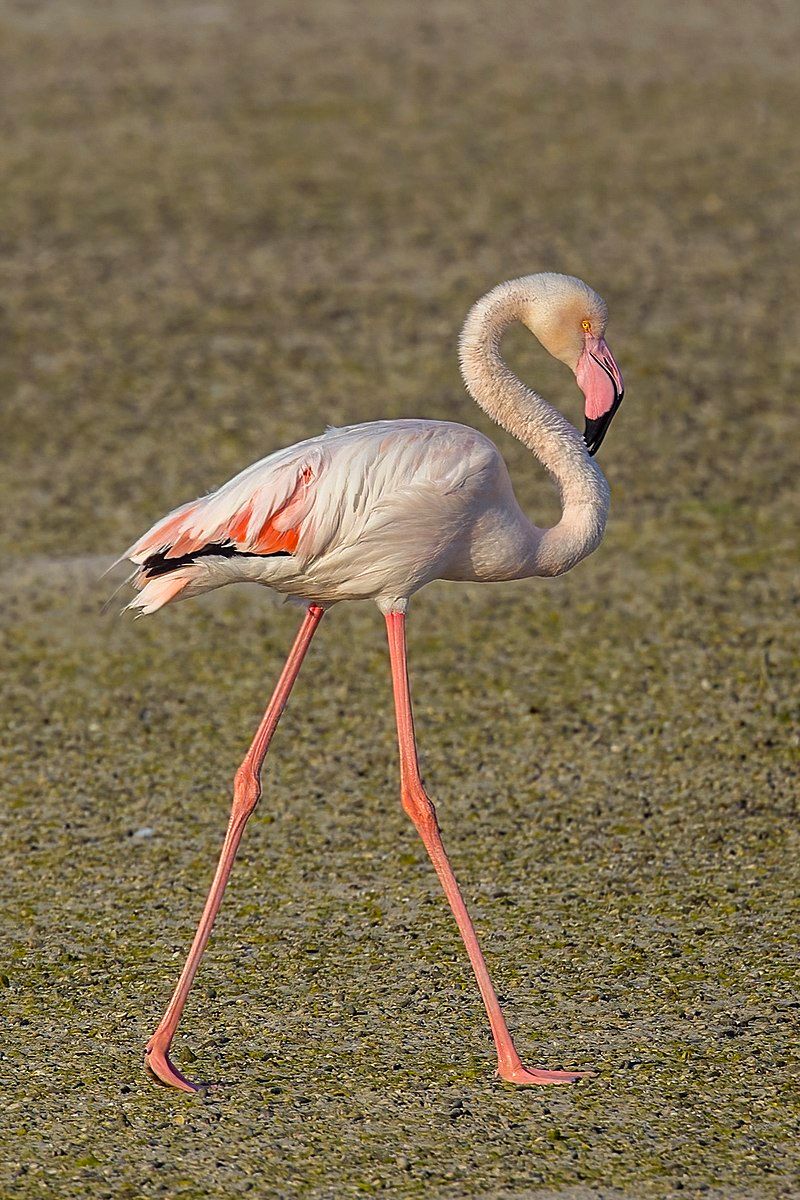
The greater flamingo is one of the most prominent members of the flamingo family. It is the largest of its kind in various areas worldwide.
In Africa, its range extends to the Northern and Sub-Saharan regions. At the same time, in Asia, it is located in the Indian Subcontinent, the Middle East, the Levant, the Persian Gulf, the Gulf of Aden, the Red Sea, and the Mediterranean countries of Southern Europe.
The greater flamingo is quite a sight, with its long legs, pinkish-orange feathers, and curved neck.
It is known for its graceful posture and its long, thin bill. Its wingspan can reach up to 1.8 meters, and it usually stands at a height of 1.2 meters.
Its diet includes a variety of aquatic plants, algae, and mollusks, which it filters out of the water with its bill. The greater flamingo is also an essential part of many different cultures.
In some places, it symbolizes luck and good fortune; in others, it is seen as a sign of fertility and abundance.
Its bright plumage and remarkable size make it a sight to behold, and its presence in many different habitats worldwide is a testament to its adaptability and resilience.
| Kingdom | Animalia |
| Phylum | Chordata |
| Class | Aves |
| Order | Phoenicopteriformes |
| Family | Phoenicopteridae |
| Genus | Phoenicopterus |
| Species | P. roseus |
4. Emerald-Spotted Wood Dove
The emerald-spotted wood dove is a bird found in Africa. It is a Columbidae family member, including other doves and pigeons. It is native to eastern and southern Africa and generally resides in open, dry, deciduous woodlands and areas with second-growth vegetation.
These areas with shrubs and small trees can thrive in the partial shade of the more giant trees.
The emerald-spotted wood dove is not found in evergreen rainforests, which are too dense and humid, or in semidesert areas, which lack the vegetation it requires for food and shelter.
| Kingdom | Animalia |
| Phylum | Chordata |
| Class | Aves |
| Order | Columbiformes |
| Family | Columbidae |
| Genus | Turtur |
| Species | T. chalcospilos |
5. Namaqua Dove
The Namaqua dove is a small pigeon species and the only one in the genus Oena. This bird species is found in many locations, including Sub-Saharan Africa, Arabia, and Madagascar.
It is a small bird, usually about 18 cm long, with a distinctive black-and-white pattern on its wings. It is also known for its distinct call, a low, hollow cooing sound.
The Namaqua dove is a pretty common species and is found in a variety of habitats. It is found in arid and semi-arid grasslands, savannahs, and scrublands. It is also commonly found in woodlands, open forests, and urban areas.
The Namaqua dove feeds primarily on seeds, along with some insects. It forages mainly on the ground and sometimes feeds on low-lying branches and shrubs. It usually feeds in small flocks and is known to migrate seasonally.
The Namaqua dove is an essential species to its habitats and ecosystems. It is an important seed disperser, helping to spread the seeds of various plants throughout its range. It is also an essential food source for many predators, particularly birds of prey.
| Kingdom | Animalia |
| Phylum | Chordata |
| Class | Aves |
| Order | Columbiformes |
| Family | Columbidae |
| Genus | Oena |
| Species | O. capensis |
6. Lesser Flamingo
The lesser flamingo is a flamingo species commonly found in sub-Saharan Africa and western India. This species of flamingo is typically seen in these regions, but there have been reports of the birds being seen further north.
However, these sightings are usually considered to be rare occurrences or vagrants. The lesser flamingo is generally easily identified by its reddish-pink color and slender body shape.
They typically feed and nest in large colonies, gathering in shallow waters to feast on algae and small aquatic invertebrates. The diet of these birds is mainly composed of these two items, as well as some brine shrimp.
The lesser flamingo is also an amiable bird, often gathering in large flocks to feed.
| Kingdom | Animalia |
| Phylum | Chordata |
| Class | Aves |
| Order | Phoenicopteriformes |
| Family | Phoenicopteridae |
| Genus | Phoeniconaias |
| Species | P. minor |
7. Grey-Breasted Spurfowl
The Grey-breasted Spurfowl is a bird species belonging to the family Phasianidae. It is native to Tanzania, where it can be found exclusively.
It was initially described by the German ornithologist Anton Reichenow in 1887 and was given its scientific name of Pternistis rufopictus. The Grey-breasted Spurfowl is a medium-sized bird with a grey breast, black head and back, and white spots on its wings and tail.
Its beak is dark grey, and its legs are yellowish. It inhabits open woodlands, grasslands, and agricultural areas in Tanzania. The Grey-breasted Spurfowl feeds mainly on insects, seeds, and fruits, usually seen in pairs or small groups.
It is also known to be a territorial species, with males making loud calls during the breeding season to mark their territory. The Grey-breasted Spurfowl is an essential species for conserving biodiversity in Tanzania.
It is listed as Vulnerable on the IUCN Red List, and its population is declining due to habitat loss and degradation. To ensure its survival, it is essential to protect its habitat and minimize any disturbance to its breeding grounds.
| Kingdom | Animalia |
| Phylum | Chordata |
| Class | Aves |
| Order | Galliformes |
| Family | Phasianidae |
| Genus | Pternistis |
| Species | P. rufopictus |
8. Flamingo
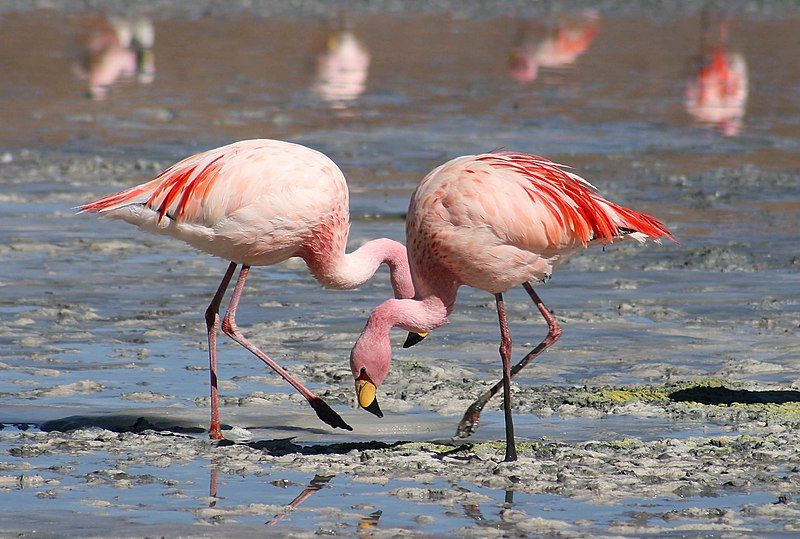
Flamingos are a type of wading bird from the Phoenicopteridae family, the only existing family in the order Phoenicopteriformes. The flamingo species can be found throughout the Americas and in two species in Afro-Eurasia.
Flamingos have a unique group name called “flamboyance.” Flamboyance is a group of flamingos, with flocks often gathering in large groups. Flamingos have beautiful pink plumage with unique coloring, making them distinct species.
They usually feed in shallow lagoons, estuaries, and other wetlands, using their long, curved beaks to filter food from the water. Flamingos also have webbed feet, which help them to move quickly through the water.
Flamingos are social creatures, often gathering in large flocks to feed and socialize. They are a unique and fascinating species and a sight to behold in the wild.
| Kingdom | Animalia |
| Phylum | Chordata |
| Class | Aves |
| Order | Phoenicopteriformes |
| Family | Phoenicopteridae |
9. Cuckoos
Cuckoos are a family of birds belonging to the Cuculidae family and the only birds in the Cuculiformes order.
The cuckoo family includes some of the most recognizable birds, such as the standard or European cuckoo, roadrunners, koels, malkohas, couas, coucals, and anis.
Although they are all part of the same family, some of these birds are sometimes split into distinct families, such as the coucals and anis, which are classified as the Centropodidae and Crotophagidae families.
Cuckoos are generally found in warm climates and have adapted to various habitats, from tropical rainforests to temperate woodlands. They feed on a wide range of insects, larvae, other invertebrates, and some plant material.
They are also known for their distinctive call, which signals the bird’s presence.
| Kingdom | Animalia |
| Phylum | Chordata |
| Class | Aves |
| Clade | Otidimorphae |
| Order | Cuculiformes |
| Family | Cuculidae |
10. Guineafowls
Guineafowl are members of the Numididae family, part of the order Galliformes. This order is made up of birds that are related to chickens, grouse, and quails. Guineafowl are native to Africa and are one of the oldest members of the Galliformes family.
They evolved from the core Galliformes, which includes the Cracidae and Odontophoridae, after the former and before the latter.
This means that the guineafowl are somewhat intermediate between these two families, having evolved from the Cracidae but not yet reaching the stage of the Odontophoridae.
| Kingdom | Animalia |
| Phylum | Chordata |
| Class | Aves |
| Order | Galliformes |
| Family | Numididae |
11. Pigeons and Doves
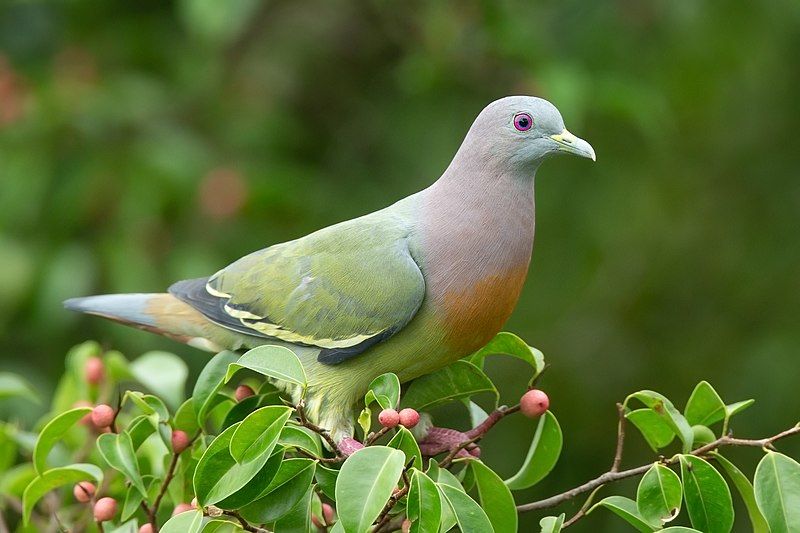
Columbidae is a bird family that includes both doves and pigeons. They are the only birds in the Columbiformes order, with stout bodies, short necks, and short and slender bills.
Some species of Columbidae also have fleshy growths on their bills called ceres. These birds mainly feed on different seeds, fruits, and plants. They are omnivorous birds that can find food in a variety of places.
They are also often found in urban and suburban areas, as they can adapt to different living environments. Columbidae birds are known for their cooing and are usually kept as pets due to their friendly and gentle nature.
| Kingdom | Animalia |
| Phylum | Chordata |
| Class | Aves |
| Clade | Columbimorphae |
| Order | Columbiformes |
| Family | Columbidae |
12. Marabou Stork
The marabou stork is a species of large wading bird that is part of the Ciconiidae family. This species is natively found in sub-Saharan Africa and can be seen in wet and arid habitats.
This species is not afraid to be near human habitation and is often seen near landfill sites. The marabou stork has a wide wingspan, and its large size makes it appear unsafe. It has a bald head, neck, white body, and black wings.
This species primarily feeds on carrion but will also eat small amphibians, reptiles, and invertebrates. Its large size allows it to hunt larger prey, such as tortoises and flamingos.
The marabou stork is an essential scavenger species in Africa, helping to clean up carcasses and prevent the spread of diseases. The marabou stork is an important species to the African environment, and its conservation status is currently listed as Least Concern by the IUCN.
| Kingdom | Animalia |
| Phylum | Chordata |
| Class | Aves |
| Order | Ciconiiformes |
| Family | Ciconiidae |
| Genus | Leptoptilos |
| Species | L. crumenifer |
13. Scaly Francolin
The Scaly Spurfowl is a bird species belonging to the Phasianidae family.
This type of bird is commonly found in various African countries, including Angola, Burundi, Cameroon, Central African Republic, Republic of the Congo, Democratic Republic of the Congo, Equatorial Guinea, Ethiopia, Gabon, Kenya, Malawi, Nigeria, Rwanda, São Tomé and Príncipe, Sudan, Tanzania, and Uganda.
The Scaly Spurfowl is a medium-sized bird with a body length of about 33 cm. Its plumage is mainly brown and has a distinctive scaled pattern on its wings and tail.
These birds inhabit dry savannas and grasslands, where they feed on a variety of small insects, as well as seeds and fruits. They usually nest on the ground in small hollows or low shrubs.
Scaly Spurfowls are usually seen in groups of two to four individuals and are known to be quite vocal. They make various loud, high-pitched calls, which are used for communication purposes.
The Scaly Spurfowl is an essential species in the African environment, as it controls insect populations.
| Kingdom | Animalia |
| Phylum | Chordata |
| Class | Aves |
| Order | Galliformes |
| Family | Phasianidae |
| Genus | Pternistis |
| Species | P. squamatus |
14. Helmeted Guineafowl
The helmeted guineafowl is a species of bird that belongs to the Numididae family. It is the only member of the genus Numida and is native to Africa, south of the Sahara.
In addition to its native range, it has been introduced to other parts of the world, such as the West Indies, North America, Colombia, Brazil, Australia, and Europe, where it is kept as a domesticated species.
The helmeted guineafowl is easily recognizable by its distinctive helmet-like crest, which gives it its common name. It has a slate-grey plumage with white spots and a fleshy, bright-red wattle on its neck.
It is a medium-sized bird measuring 27 and 32 cm in length. The helmeted guineafowl is an omnivorous species, feeding on various insects, seeds, fruits, and other plant material.
It is also known to consume small reptiles and amphibians and is known to be a helpful pest-control species. They live in small family groups and can be seen in open grassland, savannahs, and scrubland habitats.
It is a gregarious species with a loud, distinctive call, often used to signal danger to other members of its flock. They are also known to be social animals and will often congregate in large flocks to roost or forage.
The helmeted guineafowl is an important species, both culturally and economically. It is hunted for its meat and feathers, which are used for decorative purposes. Its eggs are also collected for food, and its droppings are used as fertilizer.
| Kingdom | Animalia |
| Phylum | Chordata |
| Class | Aves |
| Order | Galliformes |
| Family | Numididae |
| Genus | Numida |
| Species | N. meleagris |
15. Red-Eyed Dove
The red-eyed dove is a bird that is native to Sub-Saharan Africa. It is a common bird in the region found in many different habitats. Its population is considered stable and does not face any immediate threat of extinction.
The International Union for Conservation of Nature (IUCN) has classified the red-eyed dove as Least Concern since 2004 due to its abundance and wide range.
This classification is based on the fact that the species is not facing any significant threats and is not declining. The red-eyed dove is a widespread species amongst birdwatchers and is often seen foraging in gardens and open areas.
In addition, it is also a popular pet amongst some bird owners due to its beautiful and unique coloration.
| Kingdom | Animalia |
| Phylum | Chordata |
| Class | Aves |
| Order | Columbiformes |
| Family | Columbidae |
| Genus | Streptopelia |
| Species | S. semitorquata |
16. Nightjars and Allies
Nightjars are birds found in the family Caprimulgidae and order Caprimulgiformes. They are generally medium-sized nocturnal or crepuscular, meaning they are active during the night or the twilight hours of dawn and dusk.
Nightjars have long wings, short legs, and concise bills, which sets them apart from other birds. The nightjars’ long wings and short legs indicate that they are adapted for fast flight, allowing them to pursue flying insects at night.
The short bill also helps with this adaptation, as it reduces the drag while they are flying. Nightjars typically have cryptic plumage, meaning their feathers are patterned to help them blend in with their environment.
This helps them to avoid predators and to surprise their prey. Many species also have specialized feathers around their eyes, which allow them to see better in the dark. Nightjars are found all over the world, except for Antarctica.
They inhabit many habitats, from deserts to forests, grasslands, and wetlands. Many species of nightjars are migratory, traveling to warmer climates in the winter. Nightjars are an essential part of the food web, as they help to keep insect populations in check.
They are also essential pollinators, helping to spread the pollen of many plants as they fly from flower to flower. Nightjars are fascinating birds that play a crucial role in many ecosystems.
| Kingdom | Animalia |
| Phylum | Chordata |
| Class | Aves |
| Clade | Strisores |
| Order | Caprimulgiformes |
| Family | Caprimulgidae |
17. Phasianidae
The Phasianidae family comprises a wide variety of birds, generally found on the ground and characterized by their large size.
This family includes some of the world’s most popular gamebirds, such as pheasants, partridges, junglefowl, chickens, turkeys, Old World quail, and peafowl. The Phasianidae family consists of 185 species, separated into 54 genera.
These birds are primarily found in the wild, although some species, such as chickens and turkeys, have been domesticated. Pheasants, partridges, and quail are popular gamebirds, and their meat is highly sought after for its flavor and texture.
Junglefowl, related to chickens, are popular gamebirds often hunted for their colorful plumage. Chickens and turkeys are also popular gamebirds but are primarily kept as domestic animals for their meat, eggs, and feathers.
Peafowl are also kept as domestic animals and are prized for their ornamental plumage. The Phasianidae family provides a wide range of birds, both wild and domesticated. These birds offer the world a unique and diverse range of tastes, textures, and colors.
Whether you’re looking for a tasty gamebird or a beautiful ornamental bird to keep as a pet, the Phasianidae family has something to offer.
| Kingdom | Animalia |
| Phylum | Chordata |
| Class | Aves |
| Order | Galliformes |
| Family | Phasianidae |
18. Swifts
The swifts are a family of birds belonging to the order Apodiformes, including hummingbirds. They are known for their aerial acrobatics and are often mistaken for swallows due to their similar shape.
However, swifts are not closely related to any species in the passerine family, a perching bird family. Swifts can spend almost all their lives in the air, using their long wings and streamlined bodies to reach incredible speeds.
They nest in hollow trees or crevices in buildings and feed on airborne insects. Swifts have adapted to life in the air and evolved specialized traits to make their lives easier.
They have short and stiff feathers that provide added aerodynamic lift, and their legs are short and weak, so they don’t get in the way of their flight.
Swifts are a fantastic example of a species that has evolved to live in an extreme environment, and their aerial acrobatics are sure to amaze any onlooker.
| Kingdom | Animalia |
| Phylum | Chordata |
| Class | Aves |
| Clade | Strisores |
| Order | Apodiformes |
| Family | Apodidae |
19. Martial Eagle
The martial eagle is a large species of eagle that is native to sub-Saharan Africa. It is the only member of its genus Polemaetus, part of the booted eagle subfamily. Its distinguishing feature is the feathers that cover its tarsus, the lower part of its legs.
The martial eagle is an impressively large bird of prey with a wingspan of up to 2.5 meters and a weight of up to 4.5 kilograms. The martial eagle is a carnivore whose diet consists mainly of small mammals, birds, reptiles, and insects.
It is an opportunistic hunter who will take advantage of any convenient prey.
It hunts from a height, soaring through the air in search of its prey and then diving to snatch it up. The martial eagle is a powerful and majestic bird and an essential part of the African ecosystem.
Unfortunately, its population is declining due to human activities such as habitat destruction, persecution, and the illegal trade of its feathers. Conservation efforts are underway to protect this species and ensure its survival in the wild.
| Kingdom | Animalia |
| Phylum | Chordata |
| Class | Aves |
| Order | Accipitriformes |
| Family | Accipitridae |
| Genus | Polemaetus |
| Species | P. bellicosus |
20. Blue-Spotted Wood Dove
The blue-spotted wood dove is a species of bird belonging to the Columbidae family. This species is found in abundance throughout Africa south of the Sahel.
It is partially present in East Africa but not in southern Africa. The Sahel is a region of Africa that stretches from the Atlantic Ocean to the Red Sea, encompassing the Sahara Desert and its associated semi-arid climate.
Therefore, the blue-spotted wood dove can be found in areas with warmer, humid climates. The blue-spotted wood dove is a medium-sized bird, measuring up to 11 inches long.
They are mainly grey, with white patches on the wings, a white rump, and blue-spotted wings.
They feed on fruits and seeds often found in open woodlands and savannas. The blue-spotted wood dove is an important species to many areas of Africa, as it helps to disperse seeds and thus contributes to the health of the region’s ecosystems.
Since it is absent in southern Africa, conservationists need to work to ensure that this species is not lost from these areas.
| Kingdom | Animalia |
| Phylum | Chordata |
| Class | Aves |
| Order | Columbiformes |
| Family | Columbidae |
| Genus | Turtur |
| Species | T. afer |
21. Little Grebe
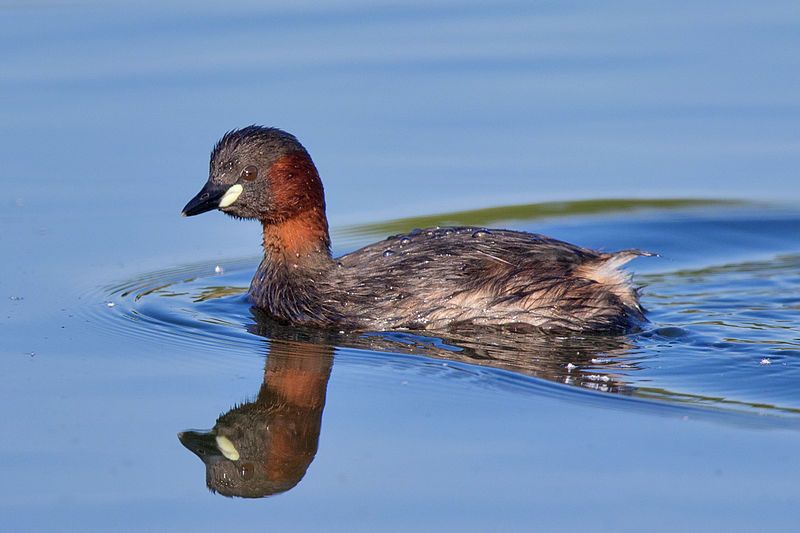
The little grebe is a small water bird that belongs to the grebe family. Its scientific name, ‘Tachybaptus ruficollis,’ is derived from Ancient Greek and Latin.
The genus name, ‘Tachybaptus,’ is derived from two Ancient Greek words – ‘thus’ meaning ‘fast’ and ‘bapto’ meaning ‘to sink under.’ The specific name, ‘ruficollis,’ is derived from two Latin words – ‘rufus’ meaning ‘red’ and ‘Collis’ meaning ‘necked.’
‘Collis’ is derived from another Latin word, ‘collum,’ which means ‘neck.’ Therefore, the scientific name of the little grebe refers to its redneck.
| Kingdom | Animalia |
| Phylum | Chordata |
| Class | Aves |
| Order | Podicipediformes |
| Family | Podicipedidae |
| Genus | Tachybaptus |
| Species | T. ruficollis |
22. Southern Pochard
The Southern Pochard is a species of waterfowl in the family Anatidae, which encompasses a large variety of ducks, geese, and swans.
The genus Netta contains two distinct subspecies of this species, the South American Pochard (N. e. erythrophthalma) and the African Pochard (N.e. brunnea).
The South American Pochard can be found in Argentina, Bolivia, Brazil, Paraguay, Peru, and Uruguay. It is also found in Chile, Columbia, Ecuador, and Venezuela.
The African Pochard is found in the countries of Angola, Benin, Burkina Faso, Cameroon, Chad, Gambia, Guinea-Bissau, Mali, Mauritania, Niger, Nigeria, Sierra Leone, and Togo. It is also found in parts of The Democratic Republic of Congo, Ethiopia, and Sudan.
Both subspecies of the Southern Pochard have similar physical characteristics. They are medium-sized ducks with a body length of 46-55 cm. They have a black head, chest, wings, and white or grayish underparts. The bill is black, and the legs are a dull orange-brown.
Both subspecies can be found in wetlands, where they feed on aquatic plants and insects. They are also known to feed on small fish. The Southern Pochard is listed as Near Threatened on the IUCN Red List due to its population decline.
This is mainly due to the destruction of its habitat, overhunting, and fishing. Conservation efforts have been put in place in many of its range countries to protect this species and help it recover.
| Kingdom | Animalia |
| Phylum | Chordata |
| Class | Aves |
| Order | Anseriformes |
| Family | Anatidae |
| Genus | Netta |
| Species | N. erythrophthalma |
23. African Olive Pigeon
The African olive pigeon, also known as the Rameron pigeon, is a species of pigeon that resides in much of eastern and southern Africa, from Ethiopia to the Cape. This species is also found in western Angola, southwestern Saudi Arabia, and northern Yemen.
The African olive pigeon is a medium-sized pigeon with a greyish-brown head, breast, greenish back, and wings. The tail is greyish-brown with a white tip. This pigeon species is usually found in wooded areas, near water, and savannahs.
It is a gregarious bird, often seen in large flocks. Its diet consists of fruits, seeds, and grains. The African olive pigeon is also known for its loud, cooing calls, often heard in the early morning and late evening.
It is an essential species in the local ecology, as it helps disperse seeds and helps maintain healthy forests.
| Kingdom | Animalia |
| Phylum | Chordata |
| Class | Aves |
| Order | Columbiformes |
| Family | Columbidae |
| Genus | Columba |
| Species | C. arquatrix |
24. Great Crested Grebe
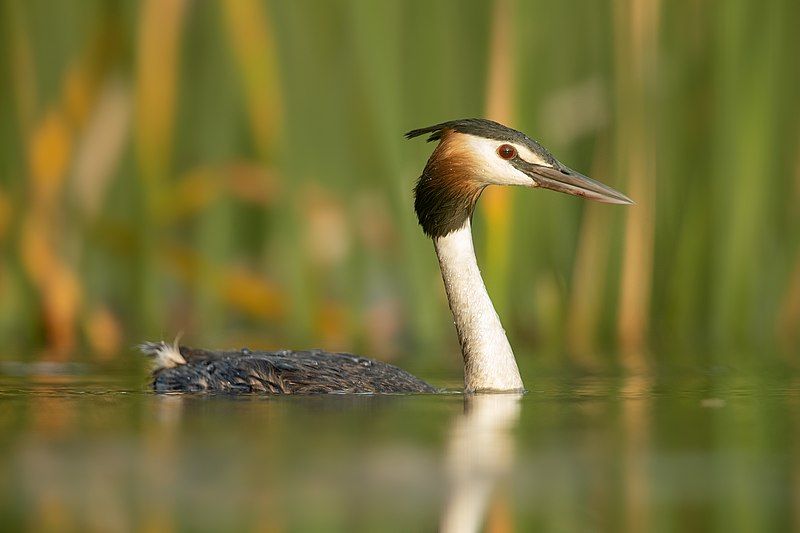
The great crested grebe is a striking water bird belonging to the grebe family. Characterized by their long-necked, thin-billed bodies and lobed feet, grebes inhabit freshwater lakes, marshes, and reservoirs worldwide.
With its distinctive white-tipped head and black neck with a red eye stripe, the great crested grebe is one of the most recognizable members of the grebe family. The great crested grebe is renowned for its elaborate mating display.
During this courtship ritual, the male and female grebes will stand facing each other, their heads bobbing up and down synchronized.
The male will then dive underwater and bring up a piece of aquatic vegetation in its bill, offering it to the female as a sign of his intent. The female will then take the vegetation from the male and swim away, leading the male in pursuit.
If the female is impressed, she will accept the male’s advances, and the pair will mate. The great crested grebe is an essential species for its beauty, grace, and role in maintaining aquatic ecosystems.
Grebes help to keep their habitats clean by consuming algae, small fish, amphibians, and aquatic insects. Additionally, their droppings provide essential nutrients to the surrounding areas.
For these reasons, the great crested grebe is a vital species and should be protected for future generations.
| Kingdom | Animalia |
| Phylum | Chordata |
| Class | Aves |
| Order | Podicipediformes |
| Family | Podicipedidae |
| Genus | Podiceps |
| Species | P. cristatus |
Conclusion
Birds in Arusha are a significant part of the natural environment and biodiversity of the region.
Not only do they provide a source of entertainment and beauty for locals and visitors alike, but their presence in the area also helps to support the local ecosystem by providing nutrients to the food web and helping to control insect populations.
Additionally, bird watching is a popular activity in Arusha that provides many visitors with a unique insight into the region’s beauty and variety of wildlife.